Introduction
It has been said that Britain acquired an empire in a fit of absent-mindedness. It might also be said that it acquired a rocketry programme in a similar fit of absent-mindedness. The UK space programme, or rocketry programme, has always been so low key that the public perception is that the UK has never even had a space programme. Yet for a time in the late 1950s and throughout the 1960s, the programme was technically as advanced as any in the world. If it did not achieve the high profiles of Sputnik, Vostok or Apollo, it is in the main because the projects were less ambitious, subject to much greater financial restrictions, and had a more modest goal. Most of the work was driven by the needs of the military. This was true too in the USA and USSR, but there the civilian effort also became caught up in the Cold War propaganda battles. Kennedy’s cry to arms ‘… to put a man on the moon before this decade is out …’ had no resonances in the UK, and the motives that drove many of the other projects in the US were also very often military in origin, even if they have been used in civilian guise. GPS began as a way for nuclear submarines to fix their position so they could launch their missiles more accurately.
It must be admitted at the outset that almost all the work described here began life as a military project designed to obliterate cities and their inhabitants. The biggest project of all described in this book is Blue Streak, whose sole purpose was to launch hydrogen bombs at the USSR. It was only later that its application to a satellite launcher was seized upon as a political fig leaf for an embarrassed Government, and even then many of the potential satellites might well have been military. Likewise, Blue Steel was intended to deliver megaton warheads. Black Knight was a research vehicle whose initial function was to act as a test bed for Blue Streak and to research re-entry vehicles for nuclear warheads. Black Arrow and Skylark were the only major projects discussed here whose applications were intended to be solely civilian and scientific.
In the end, though, the British work on rocketry and satellite launchers died, mainly as a consequence of lack of funding, political vacillation and a perceived lack of need either for satellites or other forms of space research, whether military or commercial. Although now there is a developing and thriving international commercial market for the launching of communications satellites in particular, the British rocketry programme is certainly now completely dead and there is no prospect of resurrection. All the engineers with any relevant experience have retired long ago. All the infrastructure has disappeared. It is ironic that the systems that were built and tested in the 1960s, and then abandoned, could have been commercially successful in the 1980s and 1990s. It was, perhaps, a penalty paid for being too early in the field.
To understand the story fully, we have to go back more than half a century, to the early days of the Cold War. During the Cold War era, the USA and USSR were driven by ideological pressures that the UK did not experience. Each feared the other and their systems of government. In addition, when it came to development and production of hardware, they had vastly greater resources than the UK. Indeed, the USSR can be said to have ‘lost’ the Cold War in the sense that it was driven into final collapse in part by the demands of the military and space programmes on its shaky economy. In some sense that was true for Britain as well: after Blue Streak, there was little further attempt to develop a purely indigenous deterrent system. Since the mid-1960s, the deterrent has been maintained at minimal expense.
Politically, missiles and the nuclear threat meant very different things to the UK compared with the USA and USSR. The UK had no hope of ‘winning’ a nuclear war, given its limited geography (no-one else did, but there was a perception among some in America that a nuclear war was ‘winnable’). America and Russia were driven by a paranoid fear that the one was intent on the other’s destruction, and the ideologies of the two were so far apart as to be virtually irreconcilable, despite ideas of ‘peaceful co-existence’.
The UK had no such geopolitical or ideological dynamic. It had a considerable interest in the state of Europe and the Continental balance of power, as it always has had, but that interest was to be subsumed into NATO, whose purpose, as its first Secretary General, Lord Ismay, put it, was ‘to keep the Americans in, the Russians out, and the Germans down’. The UK had also suffered tremendous economic damage in the Second World War, from which it took a long time to recover. In addition to the expenses of maintaining a far flung Empire, it also had to provide an army of occupation for Germany. One of the problems of wanting to be a Great Power is taking on the burdens and expenses of Great Power status, which Britain was less and less able to do after the war. And then the nuclear factor entered into the equation.
The story of the development of the Bomb is a complicated one, but most of the theoretical and practical work was carried out by European emigres, backed up by American know-how and resources. The UK sent many of its atomic scientists to America. The US and UK agreed to pool information, an agreement that was to fall foul of a later Act of Congress, the McMahon Act. But the British need for nuclear weapons in the immediate post-war period was not that pressing, since the only country that possessed such weapons at that time was America, Britain’s closest ally. Possession of nuclear weapons by the UK would have been useful for the influence they may have carried, but were not at that stage essential to the strategic balance, and would not have had much military significance. They have always been weapons of mass destruction, aimed more at cities than at armies.
As earlier noted, Britain’s interests were in her Empire and in Europe. In neither of these areas were nuclear weapons necessary or desirable. But that picture changed in 1949 with the explosion of the first Russian nuclear device. This was to be the first of the many scares that the Soviet Union was reaching parity with or overtaking the West technologically. The need for a British nuclear device now became that much more pressing since the Soviet Union was now perceived to be the most likely candidate for hostilities within the foreseeable future. Then came all the various nuclear scenarios that were so to bedevil military and political planners. In what circumstances would the UK need to use such weapons? In what circumstances might they be used on the UK? NATO doctrine held that an attack on one was an attack on all, but there was always the unspoken fear – would America risk nuclear annihilation for the sake of London? Or Bristol, or Birmingham? No one wanted to find out, and, fortunately, we never did.
Another factor, which should not be discounted, was that, as mentioned earlier, Britain still regarded herself as one of the leading Powers. If the other two had the Bomb, then Britain should have a Bomb too, not from any intrinsic merit of ownership, but so as to keep a seat at the Top Table. The ‘nuclear club’ was a club she felt she could not afford to be excluded from, yet could only just afford to join.
So work on a British nuclear device began very soon after the war. Soon Britain would have a working device. But there was the problem common to all three powers as to how the Bomb would be delivered. In the early post-war period, there was no alternative to the bomber, and the UK had produced some excellent jet bomber designs in the V bombers – the Valiant, Victor and Vulcan, which were to give sterling service to the UK for many years. Indeed, the Operational Requirement was issued at the end of the war, and nearly 40 years later, Vulcans were used in the Falklands conflict in the bombing role, with Victors in the tanker role.
It was realised in the early 1950s that with the increase in sophistication of missile defences, the V bombers, or bombers in general, would be increasingly vulnerable. Certainly it was expected that the likes of Moscow and other major cities would be surrounded by rings of guided weapons that could take out all but the most major bombing offensive – hence the issue of Operational Requirement OR 1132 in September 1954 for a stand-off missile, which would become Blue Steel. In 1954, the principal problem for such weapons was guidance over a long distance of flight (accuracy decreases with time of flight), and with that in mind, Blue Steel was designed with an operational range of 100 nautical miles. This would keep the bomber clear of Moscow and its attendant defences, although still leaving them with a large amount of hostile territory to cross.
At the same time, the Americans were working on various air-breathing long – range missiles, precursors of the later cruise missile. Ballistic missiles were being worked on by von Braun’s team, and by Convair under Brossart, but neither technology had advanced sufficiently to produce an effective weapons system that could deliver a nuclear device over a range of some thousands of miles. In
1954, Duncan Sandys of the UK and Charles Wilson of the US signed an agreement to share information on the development of ballistic missiles. By
1955, technology, particularly in guidance, had advanced far enough for serious design work to begin on a UK ballistic missile, Blue Streak, with a range sufficient to reach Moscow (the criterion for any UK nuclear delivery system) and beyond. At the same time, a parallel programme, called Black Knight, was also started to carry out some of the basic research, particularly on re-entry vehicles. And America began work on a much longer range missile, Atlas.
At that time, thermonuclear warheads were much more massive than they would subsequently become, and so all the early missiles designed by the US, by the USSR, and by the UK turned out to be far larger than was in the end necessary. This was to have important consequences as far as the Soviet Union and Sputnik were concerned. The enormous ballistic missile that had been developed by the Russians turned out to be much more effective as a satellite launcher. Neither the UK nor the US had designed anything quite as big as the Russian R-7, or Semiorka. Western politicians, often technically ignorant themselves and with axes to grind, assumed that these immensely powerful Russian boosters meant the Russians were that much further ahead in technology. In effect the reverse was true. The West had not built such large rockets because they were not necessary once lighter warheads had been developed.
|
Height/ft |
Mass/lb |
Thrust/lb |
|
|
Semiorka R-7 |
98 |
588,000 |
874,000 |
|
Atlas E |
92 |
260,000 |
385,000 |
|
Blue Streak* |
~70* |
198,000 |
270,000* |
|
Thor |
65 |
110,000 |
150000 |
* In its probable configuration if it had been deployed operationally.
All the early Western missiles such as Blue Streak, Thor, Atlas and Titan I, were designed to use kerosene and liquid oxygen as fuels, as did the first Soviet designs. Solid fuel rockets had not yet sufficient size or range given the weight of the warheads of the 1950s. (Minuteman and Polaris were designed assuming warheads would get lighter.) Such large rockets were also very vulnerable to a first strike attack, so would have to be stored in and fired from underground storage silos, hardened against nuclear attack. This added considerably to the expense of the system, and meant in addition that the missile and silo complex itself became a target.
All these missiles were close contemporaries in conception. Where they differed was that America and Russia pressed ahead with development despite the cost.
Development was carried on with Blue Streak as fast as funds allowed, although the whole project was bedevilled throughout its life by Treasury reluctance to release the necessary money. It could be said of the whole history of Blue Streak from 1955 to 1970 that the technical will was there, the political will was there intermittently, and the financial will was never there. It is astonishing how well the morale of those involved with the project stood up in the face of such political and financial uncertainty.
But in 1957 came the shock of Sputnik. The psychological effect on the Americans was considerable, and Atlas, among others, became a crash programme. In more than just the defence field, the US felt it had been overtaken. This led, among other things, to a massive effort in science and technical education. Its effect on British opinion was very much more muted. Britain did not see itself in any technological race, and was not perturbed by the thought of a satellite orbiting overhead. In the US, it was felt almost as an invasion of the country. Britain had suffered bombing of London as early as 1916, but the US had never experienced hostile aircraft in its skies. Sputnik was perceived in those terms.
Curiously enough, the Rand Corporation (and the RAE) had been undertaking studies into reconnaissance satellites, and had recognised that one legal problem might be that a satellite orbiting over another country may be taken as an invasion of the other country’s airspace. This is one of the reasons why the first planned US satellite was intended to be perceived as entirely civilian and part of the 1957 Geophysical Year. Sputnik had resolved this problem at a stroke. The Russians were in no position now to claim invasion of their airspace by American reconnaissance satellites.
Back in the UK, by 1958 the Black Knight rocket programme, intended to provide a lot of the basic research for Blue Streak, was up and running. It would yield a lot of useful information for the UK and the US on the physics of re-entry vehicles, necessary for any ballistic missile system, and also for studies into possible defences against them. The first flight of Blue Streak was planned for 1960, when the decision was taken by the Macmillan Government to cancel the system for military purposes. The reasons for this are complex and will be explored further in the Blue Streak chapters. In the same way that the USSR was eventually driven out of the arms race, so too was the UK, becoming increasingly reliant on the US for delivering its deterrent.
Mainly, I suspect, to minimise the political damage that ensued from the decision, it was announced that although Blue Streak had been cancelled as a weapons system, work would still continue, albeit at a much reduced rate, on developing a satellite launcher based on the missile. At least £60 million (all costs are given as of the period and not corrected for inflation), if not more, including large sums at Woomera by the Australians, had been spent on the project by this stage. A design, which would be known as Black Prince from the Saunders Roe brochure, or more inelegantly in official papers as the BSSLV (Blue Streak Satellite Launch Vehicle), had been under consideration for some time. It would have used Blue Streak as the first stage together with the proven technology of Black Knight as the second stage. Again, though, the major problem was money: one source mentioned that the development costs would amount to half the annual UK university budget, which even given the relatively small university sector in the UK at the time, gave pause for thought. And although the US military had found many uses for satellites, there was not the same perceived need by the UK military, particularly since British Intelligence had access to a good deal of the US information. Although the scientific community would have liked to launch various satellites (a stellar ultraviolet telescope was a favourite project), there were not the funds available in the civilian science research budget. Hence the UK was in danger of building a satellite launcher with no satellites to launch.
The decision was then taken to involve other nations in the project in the hope of sharing the costs. The Old Commonwealth countries were not interested, or lacked the finances and resources. France might be interested, but there was also the opportunity for France to acquire much needed data relevant to its own ballistic missile programme, which led to some difficulties and embarrassment. In the end, the European Launcher Development Organisation, ELDO, was born with little enthusiasm from many of its members. And the ELDO launcher ran into considerable criticism almost from the start, being widely perceived as unnecessary and based on obsolete technology.
The latter criticism was unfounded, although the much slower pace of development in the cash-strapped UK meant that the US tended to be there first. But Blue Streak remained irredeemably tarnished by its cancellation for military purposes. It had, however, the potential to be the equivalent of almost any American launcher until the Saturn vehicles. ELDO was both a political failure and a technical failure. Blue Streak itself performed almost flawlessly, but the same could not be said of the French and German upper stages. One of the reasons for this problem was that the other European countries were a good deal less experienced than Britain; another was that putting together a vehicle designed and built by three different teams of engineers in three different countries, speaking three different languages, was no mean feat. ELDO and its launcher died, never to be resurrected.
And what of the other project, Black Knight? After 22 successful firings, the project was declared at an end. But while the UK was still a member of ELDO, a decision was taken to proceed with an alternative, much smaller satellite launcher, and this would be based on Black Knight. The new design was called Black Arrow.
Two test vehicles were flown, one successful and one not, and then an orbital attempt failed by a small margin. On 29 July 1971, the announcement was made that Black Arrow was cancelled. However, the fourth vehicle was subsequently fired and achieved orbit on 28 October 1971, and that, effectively, was the end of rocketry in the UK. Skylark launches would continue for another 34 years, but there was little further development of the vehicle.
Space science has continued, and the UK has always been successful at building satellites. Indeed, Surrey Satellite Technology Ltd (SSTL) has been one of the major success stories of the past decade. It is also perhaps an exemplar of what the Treasury was maintaining – that if there is money to be made in space, then let private business get on with it.
Project Names
In the 1950s, the fashion in the UK was to give many of the military projects two word code names, the first of which was a colour: thus Orange Herald, Blue Streak, Yellow Sun, Red Duster, Violet Club, Green Flax and so on. A good code name should reveal nothing about the nature of the project. However, Yellow Sun for an H bomb was a bit of a giveaway, since the sun is a gigantic fusion reactor (or perhaps not: Mark 1 was not what is commonly understood by a ‘hydrogen bomb’, so perhaps there was an element of double bluff).
The rocketry projects covered in this book are Blue Steel, Blue Streak, Black Knight, Black Prince, Black Arrow and the various rocket interceptors. The ‘Black’ designations were applied, albeit unofficially, to research projects without a direct military application; indeed, Black Arrow was entirely civilian, but was named by extension from Black Knight, as probably was Black Prince.
The Rocket Propulsion Establishment (RPE) at Westcott, Buckinghamshire, produced many solid fuel rocket motors. A Superintendent who had been in charge of the Establishment had been a keen ornithologist, and so all the motors produced there were named after birds: Raven, Rook, Cuckoo, Waxwing etc.











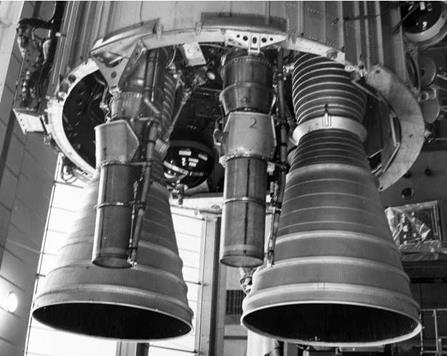
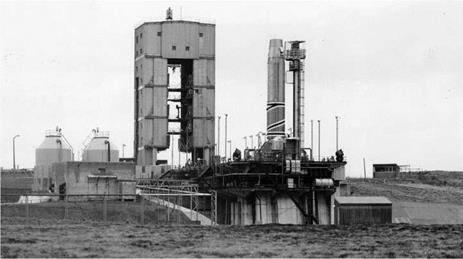
 a launcher ELDO-C which had been defined by its performance (6 to 10 tonnes in low orbit – 1.7 tonnes to escape velocity).
a launcher ELDO-C which had been defined by its performance (6 to 10 tonnes in low orbit – 1.7 tonnes to escape velocity).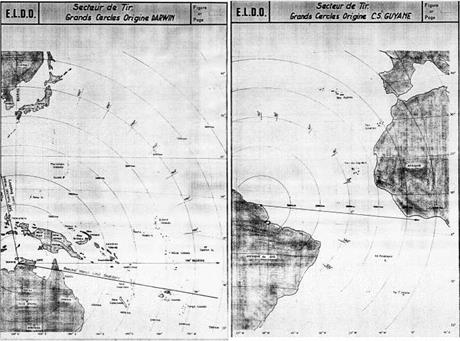
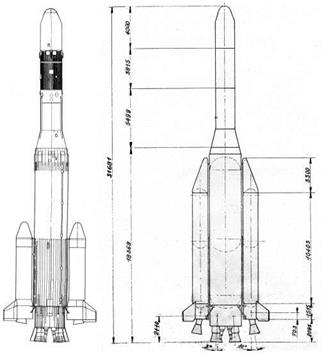
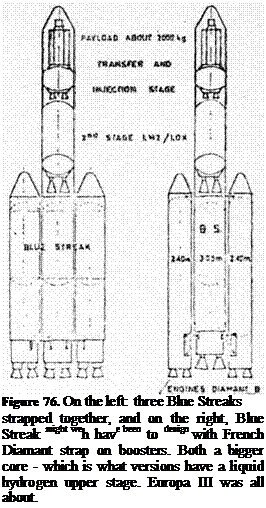 launcher… in the first case three Blue Streaks are attached together side by side and they would all be lit up together from the start. Propellant would be pumped continuously from the outer boosters to the engine of the central Blue Streak so that, at booster jettisoning, the central or core stage is still full and continues to burn for a full burning time. The version deriving from Diamant B type uses four boosters clustered around the central Blue Streak. They each have a diameter of 2.4 m, as compared with the 3 m of Blue Streak, and have 4 engines of 36 tonnes thrust each. The outer four boosters are functioning as a zero stage… i. e., the core stage is lit up at the end of the booster phase only.
launcher… in the first case three Blue Streaks are attached together side by side and they would all be lit up together from the start. Propellant would be pumped continuously from the outer boosters to the engine of the central Blue Streak so that, at booster jettisoning, the central or core stage is still full and continues to burn for a full burning time. The version deriving from Diamant B type uses four boosters clustered around the central Blue Streak. They each have a diameter of 2.4 m, as compared with the 3 m of Blue Streak, and have 4 engines of 36 tonnes thrust each. The outer four boosters are functioning as a zero stage… i. e., the core stage is lit up at the end of the booster phase only.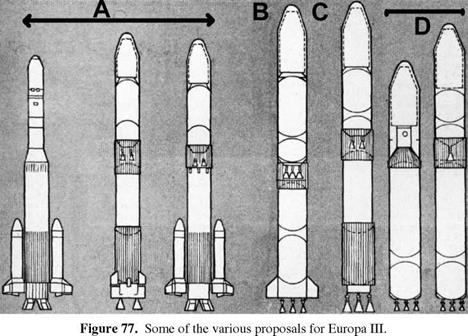
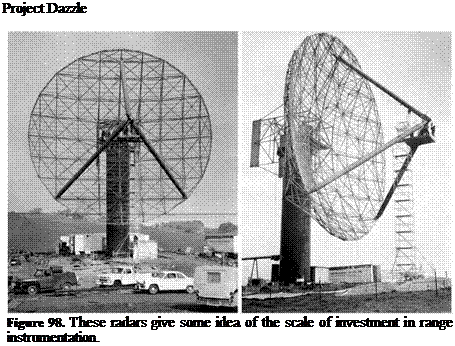
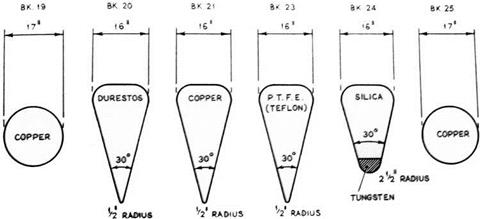
 The final six Black Knight launches were part of Project Dazzle, and the various re-entry heads can be seen in Figure 99 above. The range instrumentation was greatly improved, as can be seen in the pictures above.5 The purpose of these flights was to study reentry phenomena more closely. Dazzle was a joint UK/US/Australian project – the UK providing the vehicles and re-entry heads, Australia supplying the range facilities, and the US supplying much of the instrumentation.
The final six Black Knight launches were part of Project Dazzle, and the various re-entry heads can be seen in Figure 99 above. The range instrumentation was greatly improved, as can be seen in the pictures above.5 The purpose of these flights was to study reentry phenomena more closely. Dazzle was a joint UK/US/Australian project – the UK providing the vehicles and re-entry heads, Australia supplying the range facilities, and the US supplying much of the instrumentation.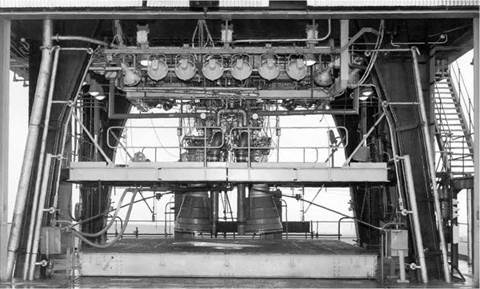
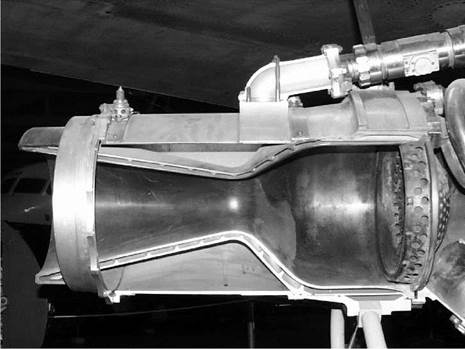

 Lizzie was used to power the Liquid Oxygen Petrol/
Lizzie was used to power the Liquid Oxygen Petrol/

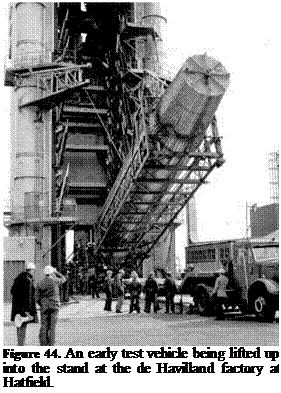 But the next, and most controversial, point about Blue Streak was to be its proposed means of deployment. To have the missile sited on the ground in the open, as the Thor missiles were, was pointless. A preemptive strike by relatively few Russian missiles would have destroyed every site before a missile could be fired in retaliation. As all sides in the Cold War realised, land-based missiles would have to be sited in ‘invulnerable’ silos, although the word ‘silo’ was not in usage in the UK at that time. Indeed, the two phrases used became code phrases, showing which side of the controversy you were on. ‘Underground launcher’ was the phrase used by those in
But the next, and most controversial, point about Blue Streak was to be its proposed means of deployment. To have the missile sited on the ground in the open, as the Thor missiles were, was pointless. A preemptive strike by relatively few Russian missiles would have destroyed every site before a missile could be fired in retaliation. As all sides in the Cold War realised, land-based missiles would have to be sited in ‘invulnerable’ silos, although the word ‘silo’ was not in usage in the UK at that time. Indeed, the two phrases used became code phrases, showing which side of the controversy you were on. ‘Underground launcher’ was the phrase used by those in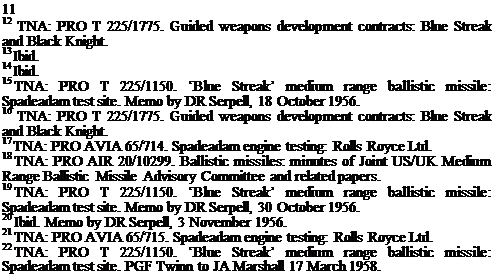 favour of the project, ‘fixed sites’ if you were against. ‘Fixed sites’ were perceived as being vulnerable. Airfields, somehow, were not perceived as being vulnerable – although they were as ‘fixed’ as any missile launcher. [4]
favour of the project, ‘fixed sites’ if you were against. ‘Fixed sites’ were perceived as being vulnerable. Airfields, somehow, were not perceived as being vulnerable – although they were as ‘fixed’ as any missile launcher. [4]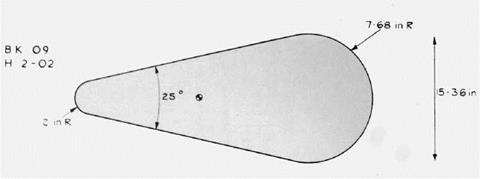
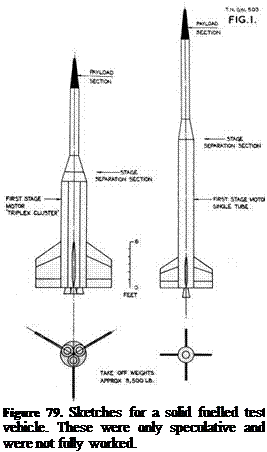 On the other hand, another way of estimating the performance of rocket vehicles, as mentioned earlier, is the mass fraction or mass ratio, which is defined as (initial mass)/(final mass). Here Black Knight would have won hands down: any British solid fuelled vehicle of the time would have had a very poor mass ratio, whereas that of Black Knight was extremely good.
On the other hand, another way of estimating the performance of rocket vehicles, as mentioned earlier, is the mass fraction or mass ratio, which is defined as (initial mass)/(final mass). Here Black Knight would have won hands down: any British solid fuelled vehicle of the time would have had a very poor mass ratio, whereas that of Black Knight was extremely good.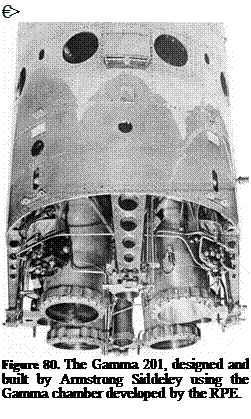 acceleration of 0.3 g meant an all-up weight of (16,400/1.3) lb or around 12,600 lb.
acceleration of 0.3 g meant an all-up weight of (16,400/1.3) lb or around 12,600 lb.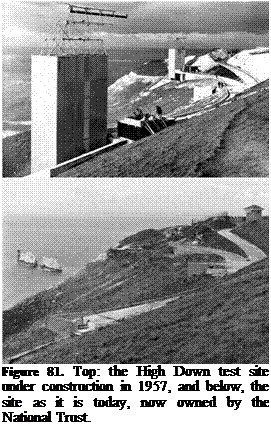 In these days of Green Belt, planning permission, NIMBYism, and so on, it seems incredible that a rocket test site could be built on one of the most scenic sites in Britain without objection, but it was also obvious from the files that the idea of anyone objecting did not occur to the official mind. The site belonged to the War Office, was now surplus to requirements, and a test site was needed. Planning permission as we now know it was not necessary in those days.
In these days of Green Belt, planning permission, NIMBYism, and so on, it seems incredible that a rocket test site could be built on one of the most scenic sites in Britain without objection, but it was also obvious from the files that the idea of anyone objecting did not occur to the official mind. The site belonged to the War Office, was now surplus to requirements, and a test site was needed. Planning permission as we now know it was not necessary in those days.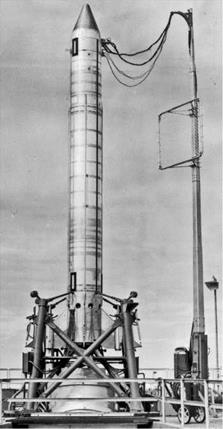 Black Knight was a slim cylinder, 3 ft in diameter. Its exact height would vary depending on the payload, but it was 32 ft 3 inches to the top of the separation bay. Initially it was a single stage vehicle; later versions used a solid fuel Cuckoo motor as a second stage. Some also used some small Imp motors to push the re-entry head away from the main body, but to describe this as a three stage version, as some RAE reports did, is being a little optimistic.
Black Knight was a slim cylinder, 3 ft in diameter. Its exact height would vary depending on the payload, but it was 32 ft 3 inches to the top of the separation bay. Initially it was a single stage vehicle; later versions used a solid fuel Cuckoo motor as a second stage. Some also used some small Imp motors to push the re-entry head away from the main body, but to describe this as a three stage version, as some RAE reports did, is being a little optimistic.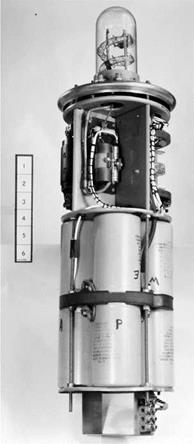 The bay between the HTP and kerosene tanks contained air bottles which were used to pressurise the HTP tank. The kerosene tank was not directly pressurised, as the hydrostatic head was sufficient to prime the pumps. One striking feature is the size of the HTP tank compared with the kerosene tank: 208 inches compared with 48 inches. The mass of HTP was over eight times that of kerosene, although the greater density meant the volume ratio was smaller.
The bay between the HTP and kerosene tanks contained air bottles which were used to pressurise the HTP tank. The kerosene tank was not directly pressurised, as the hydrostatic head was sufficient to prime the pumps. One striking feature is the size of the HTP tank compared with the kerosene tank: 208 inches compared with 48 inches. The mass of HTP was over eight times that of kerosene, although the greater density meant the volume ratio was smaller.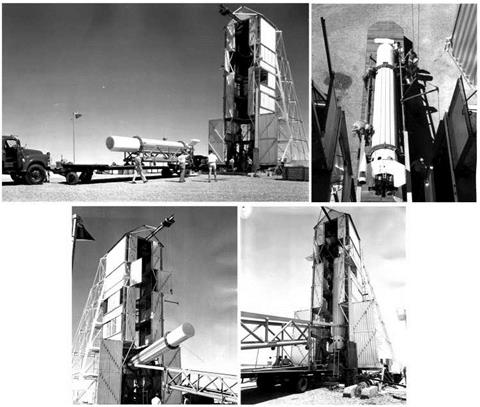

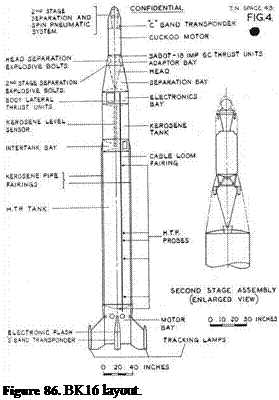 An even more elaborate system was used in later flights.
An even more elaborate system was used in later flights.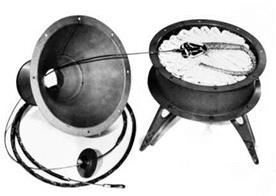 As we shall see in the next chapter, the lanyard system was not always a success for a variety of reasons.
As we shall see in the next chapter, the lanyard system was not always a success for a variety of reasons.
